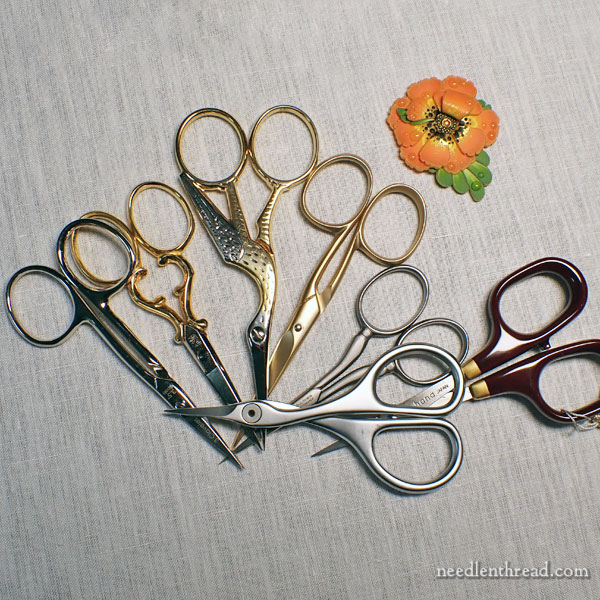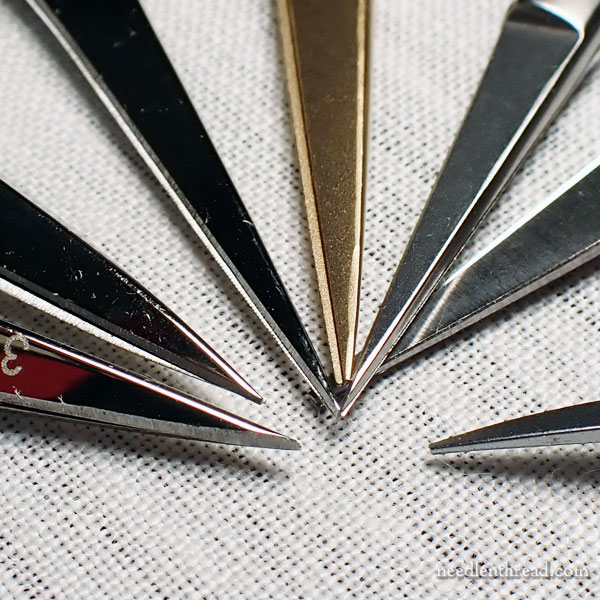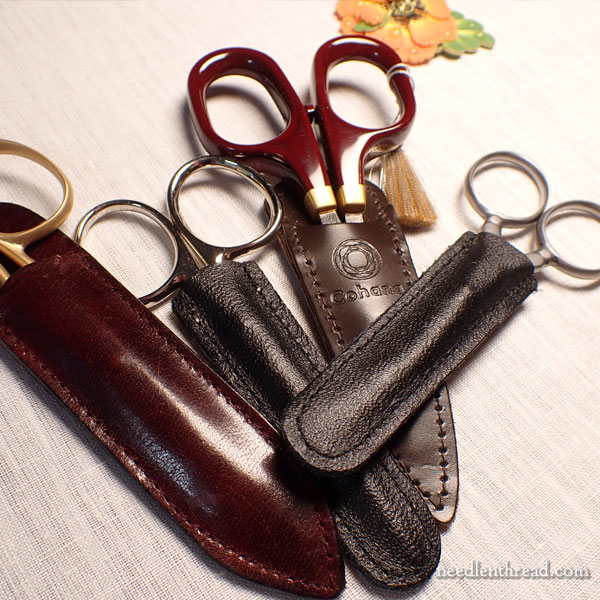Embroidery scissors! Nothing beats a Great Pair of Embroidery Scissors!
One thing that I’ve discovered over the years is that a great pair of embroidery scissors does not have to equate with a jaw-droopingly expensive pair of embroidery scissors.
In fact, I have it on very good authority that some of the most expensive embroidery scissors on the market today don’t hold a candle, mechanics & functionality-wise, to some of the comparatively moderate-to-lower-priced scissors that are available.
The measure of how good a pair of scissors is, then, doesn’t necessarily depend on the cost of the scissors.
That said, scissors that have a little more oversight and care in their design, production, and finishing are bound to be better scissors, and they often cost a little more than the blister-packet scissors you might pick up at a big-box store.
I’m going to venture a personal opinion (which isn’t unusually – I do it all the time), and it is this:
If you want a good pair of embroidery scissors, there’s more involved than just buying the scissors. Let me explain…

Scissors – good scissors – are an investment, whether you pay $20 for them, or $100 for them, or (choke) $500 for them.
Every single pair of scissors that I’ve bought in my life that I consider good scissors have been an investment.
The highest price I’ve paid for a pair of scissors was $120 for a pair of sewing shears. The lowest price I’ve paid for a pair of what turned out to be Really Good Scissors was about $15. And I’ve bought decent $8 scissors, too.
Regardless of the price tag, they’re an investment because 1. (the obvious) I paid hard-earned money for them; 2. They are good, and therefore, I want them to last, and therefore, I will invest care in them. So they get my time and attention.

Let’s talk about basic scissor care, and then I’ll mention my favorite way of ensuring the longevity of my scissors.
Some Scissor Attention Tips
You can care for your scissors a number of ways:
1. Use them for their purpose. Really good embroidery scissors should be reserved for cutting embroidery regular embroidery fibers and / or small snips of fabric. When it comes to non-regular embroidery threads – like metallics, real metal threads, beading threads (Fireline and the like) – use scissors specially designated for those tasks. Don’t use any of your embroidery scissors to cut paper, to slice open boxes, or any similar degrading use!
2. Keep your scissors in particular places (like a tool caddy or a tray) and not just flailing about, where they might end up loose in drawers or knocked off tables or banged about.
3. When they need it, have them sharpened and maintained by someone who knows how to do it and has a good reputation for it. This is only required as necessary for the scissors – if they become dull or the mechanics aren’t working like they used to. Don’t over-sharpen them. I’ve heard of people having their scissors sharpened faithfully once a year, but this is rarely necessary with a decent pair of scissors that are just used for cutting thread.
Finally, there’s this:
You’ve got the scissors, but…
Where’s the sheath?
4. Keep your scissors in a sheath.
A sheath is a protective sleeve that you can slide your scissors (or any blade, really – knives have sheaths, too) into, in order to protect them.

But it’s more than that!
Protection of the scissor tips and blades may be a sheath’s obvious and perhaps primary purpose, but it’s not its only purpose.
The sheath protects everything around the scissors, too.
Scissors, after all, are sharp. Drop of pair of embroidery scissors, unsheathed, into your embroidery project bag, and you risk damage not only to the scissors, but to the stuff in the bag and to the bag itself.
The sheath doesn’t have to be some fancy-schmancy thing. Sure, the higher the price of the scissors, if they come with a sheath, the more likely it’s going to be a nicer sheath of some sort. But I’m not picky when it comes to a sheath.
If it’s a plastic casing that fits over the blades, that’s ok! Leatherette, vinyl, synthetic something or other – it’s fine! Sufficient unto the scissors is the sheath thereof. As long as the sheath covers the blades, keeping them and everything around them in good condition, I’m happy.
If your scissors don’t have a sheath, you can always make your own, too. It’s really just two pieces of (something) sewn (or glued) together that will cover the scissor blades snuggly, without falling off.
Most needlework shops will have sheaths on hand for scissor purchases, or sheaths for sale. Sometimes, the sheath is swag for the shop, and when you make a scissor purchase, they include a sheath with the shop’s name on them. That’s great!
So, next time you’re in the market for a pair of embroidery scissors, don’t hesitate to ask, “Where’s the sheath?”
Got any tips for scissor care? We’d all love to hear ’em. Feel free to join the scissor chatter in the comment section here!



